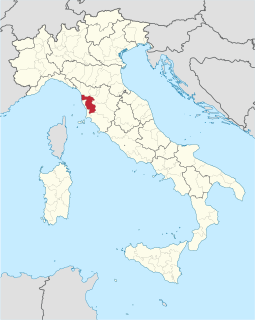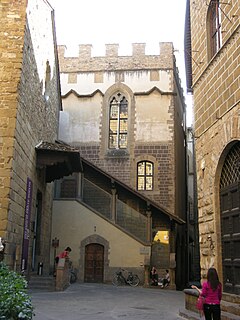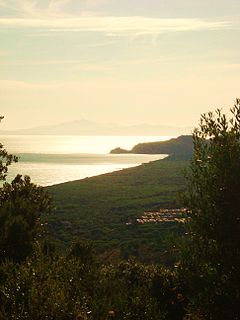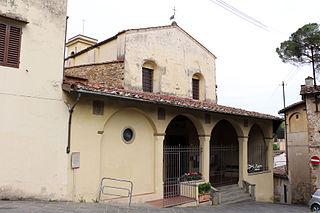


The Palazzo al Borgo di Corliano is a villa situated near coast of Tuscany, central Italy, in the valley between Lucca and Pisa, 2 kilometres from the Spa town of San Giuliano Terme. It is one of the numerous villas that built by the Pisan merchants as summer houses, along the fertile west slopes of Mount Pisano.
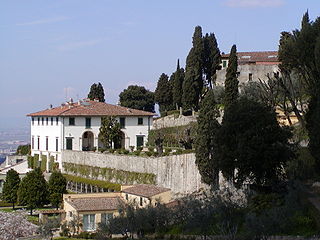
A villa was originally an ancient Roman upper-class country house. Since its origins in the Roman villa, the idea and function of a villa has evolved considerably. After the fall of the Roman Republic, villas became small farming compounds, which were increasingly fortified in Late Antiquity, sometimes transferred to the Church for reuse as a monastery. Then they gradually re-evolved through the Middle Ages into elegant upper-class country homes. In modern parlance, "villa" can refer to various types and sizes of residences, ranging from the suburban semi-detached double villa to residences in the wildland–urban interface.

Tuscany is a region in central Italy with an area of about 23,000 square kilometres and a population of about 3.8 million inhabitants (2013). The regional capital is Florence (Firenze).

Italy, officially the Italian Republic, is a country in Southern Europe. Located in the middle of the Mediterranean Sea, Italy shares open land borders with France, Switzerland, Austria, Slovenia and the enclaved microstates San Marino and Vatican City. Italy covers an area of 301,340 km2 (116,350 sq mi) and has a largely temperate seasonal and Mediterranean climate. With around 61 million inhabitants, it is the fourth-most populous EU member state and the most populous country in Southern Europe.
On both sides of the villa, decorated with typical Florentine Mannerist 16th-century graffiti (harpy eagles, fruit crowns and flowers, birds and other symbols, representing the virtues of Fortress, Abundance and Fortune) are the farm and the oil mill, dating to the end of the 17th century. In 1755, on the occasion of the wedding of Maria Teresa Scolastica Ottavia della Seta Gaetani Bocca with Count Cosimo Baldassarre Agostini Fantini Venerosi, the villa was restored by the Veronese architect Ignazio Pellegrini.
In the vestibule there are some 18th-century marble busts representing Roman Emperors, while the vault is painted with a mythological scene representing Paris awarding Venus the fruit, under the watchful June and Minerva’s stare. In the lateral ovals there are the Cathedral Square of Pisa, the original view of the villa, Piana della Croce Mount (Apuan Alps), the Gulf of Lerici, two unknown castles and the commissioners’ portraits. In the central hall is a vault, with a fresco representing The Gods’ Banquet) and months and zodiacal signs allegorical representations, by the Florentine painter Andrea Boscoli. On the walls are 18th-century fresco paintings with the Four Seasons, attributed to Natili and Matraini, as are the ones in the little church.

The Piazza dei Miracoli, formally known as Piazza del Duomo, is a walled 8.87-hectare area located in Pisa, Tuscany, Italy, recognized as an important centre of European medieval art and one of the finest architectural complexes in the world. Considered sacred by the Catholic Church, its owner, the square is dominated by four great religious edifices: the Pisa Cathedral, the Pisa Baptistry, the Campanile, and the Camposanto Monumentale. Partly paved and partly grassed, the Piazza dei Miracoli is also the site of the Ospedale Nuovo di Santo Spirito, which houses the Sinopias Museum and the Cathedral Museum.
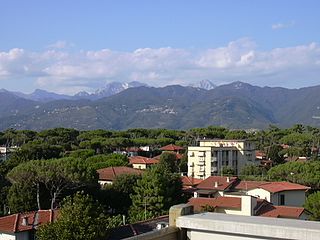
The Apuan Alps are a mountain range in northern Tuscany, Italy. They are included between the valleys of the Serchio and Magra rivers, and, to the northwest, the Garfagnana and Lunigiana, with a total length of approximately 55 kilometres (34 mi).

Andrea Boscoli was an Italian painter of the Renaissance.
The 4 hectares private park has been changed several times in the centuries, according to the different age's trends. The current garden layout is from the 19th century.

The hectare is an SI accepted metric system unit of area equal to a square with 100-metre sides, or 10,000 m2, and is primarily used in the measurement of land. There are 100 hectares in one square kilometre. An acre is about 0.405 hectare and one hectare contains about 2.47 acres.

A park is an area of natural, semi-natural or planted space set aside for human enjoyment and recreation or for the protection of wildlife or natural habitats. Urban parks are green spaces set aside for recreation inside towns and cities. National parks and Country parks are green spaces used for recreation in the countryside. State parks and Provincial parks are administered by sub-national government states and agencies. Parks may consist of grassy areas, rocks, soil and trees, but may also contain buildings and other artifacts such as monuments, fountains or playground structures. Many parks have fields for playing sports such as soccer, baseball and football, and paved areas for games such as basketball. Many parks have trails for walking, biking and other activities. Some parks are built adjacent to bodies of water or watercourses and may comprise a beach or boat dock area. Urban parks often have benches for sitting and may contain picnic tables and barbecue grills.
Corliano belongs to a wider estate complex constituted by the ancient villa, the aristocratic chapel, the farm, the oil mill, stables, the kaffeehaus, the park, rural annexes, the boundary wall and monumental entrance, which was under control due to its historical-artistic interest pursuant to Italian Laws.



